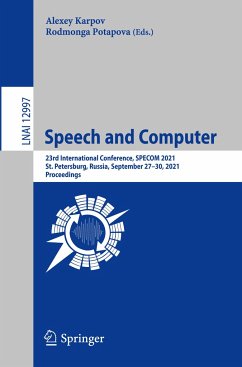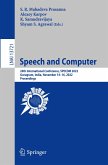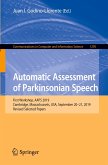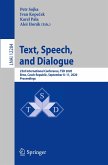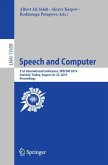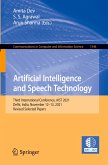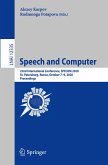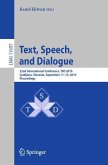Speech and Computer
23rd International Conference, SPECOM 2021, St. Petersburg, Russia, September 27-30, 2021, Proceedings
Herausgegeben:Karpov, Alexey; Potapova, Rodmonga
Speech and Computer
23rd International Conference, SPECOM 2021, St. Petersburg, Russia, September 27-30, 2021, Proceedings
Herausgegeben:Karpov, Alexey; Potapova, Rodmonga
- Broschiertes Buch
- Merkliste
- Auf die Merkliste
- Bewerten Bewerten
- Teilen
- Produkt teilen
- Produkterinnerung
- Produkterinnerung
This book constitutes the proceedings of the 23rd International Conference on Speech and Computer, SPECOM 2021, held in St. Petersburg, Russia, in September 2021._
The 74 papers presented were carefully reviewed and selected from 163 submissions. The papers present current research in the area of computer speech processing including audio signal processing, automatic speech recognition, speaker recognition, computational paralinguistics, speech synthesis, sign language and multimodal processing, and speech and language resources.
_Due to the COVID-19 pandemic, SPECOM 2021 was held as a hybrid event.…mehr
Andere Kunden interessierten sich auch für
![Speech and Computer Speech and Computer]() Speech and Computer82,99 €
Speech and Computer82,99 €![Automatic Assessment of Parkinsonian Speech Automatic Assessment of Parkinsonian Speech]() Automatic Assessment of Parkinsonian Speech38,99 €
Automatic Assessment of Parkinsonian Speech38,99 €![Text, Speech, and Dialogue Text, Speech, and Dialogue]() Text, Speech, and Dialogue67,99 €
Text, Speech, and Dialogue67,99 €![Speech and Computer Speech and Computer]() Speech and Computer38,99 €
Speech and Computer38,99 €![Artificial Intelligence and Speech Technology Artificial Intelligence and Speech Technology]() Artificial Intelligence and Speech Technology82,99 €
Artificial Intelligence and Speech Technology82,99 €![Speech and Computer Speech and Computer]() Speech and Computer75,99 €
Speech and Computer75,99 €![Text, Speech, and Dialogue Text, Speech, and Dialogue]() Text, Speech, and Dialogue38,99 €
Text, Speech, and Dialogue38,99 €-
-
-
This book constitutes the proceedings of the 23rd International Conference on Speech and Computer, SPECOM 2021, held in St. Petersburg, Russia, in September 2021._
The 74 papers presented were carefully reviewed and selected from 163 submissions. The papers present current research in the area of computer speech processing including audio signal processing, automatic speech recognition, speaker recognition, computational paralinguistics, speech synthesis, sign language and multimodal processing, and speech and language resources.
_Due to the COVID-19 pandemic, SPECOM 2021 was held as a hybrid event.
The 74 papers presented were carefully reviewed and selected from 163 submissions. The papers present current research in the area of computer speech processing including audio signal processing, automatic speech recognition, speaker recognition, computational paralinguistics, speech synthesis, sign language and multimodal processing, and speech and language resources.
_Due to the COVID-19 pandemic, SPECOM 2021 was held as a hybrid event.
Produktdetails
- Produktdetails
- Lecture Notes in Computer Science 12997
- Verlag: Springer / Springer International Publishing / Springer, Berlin
- Artikelnr. des Verlages: 978-3-030-87801-6
- 1st ed. 2021
- Seitenzahl: 860
- Erscheinungstermin: 22. September 2021
- Englisch
- Abmessung: 235mm x 155mm x 46mm
- Gewicht: 1276g
- ISBN-13: 9783030878016
- ISBN-10: 3030878015
- Artikelnr.: 62469335
- Herstellerkennzeichnung Die Herstellerinformationen sind derzeit nicht verfügbar.
- Lecture Notes in Computer Science 12997
- Verlag: Springer / Springer International Publishing / Springer, Berlin
- Artikelnr. des Verlages: 978-3-030-87801-6
- 1st ed. 2021
- Seitenzahl: 860
- Erscheinungstermin: 22. September 2021
- Englisch
- Abmessung: 235mm x 155mm x 46mm
- Gewicht: 1276g
- ISBN-13: 9783030878016
- ISBN-10: 3030878015
- Artikelnr.: 62469335
- Herstellerkennzeichnung Die Herstellerinformationen sind derzeit nicht verfügbar.
Text-Independent Speaker Verification Employing CNN-LSTM-TDNN Hybrid Networks.- End-to-End Voice Spoofing Detection Employing Time Delay Neural Networks and Higher Order Statistics.- Assessing Velar Gestures Timing in European Portuguese Nasal Vowels with RT-MRI Data.- Designing and Deploying an Interaction Modality for Articulatory-Based Audiovisual Speech Synthesis.- Kurdish Spoken Dialect Recognition Using X-vector Speaker Embedding.- An ASR-based Tutor for Learning to Read: How to Optimize Feedback to First Graders.- Velocity Differences Between Velum Raising and Lowering Movements.- Pragmatic Markers of Russian Everyday Speech: Invariants in Dialogue and Monologue.- Language Adaptation for Speaker Recognition Systems using Contrastive Learning.- Evaluating X-vector-based Speaker Anonymization Under White-box Assessment.- Improved Prosodic Clustering for Multispeaker and Speaker-Independent Phoneme-Level Prosody Control.- Initial Experiments on Question Answering from the Intrinsic Structure of Oral History Archives.- Imagined, Intended, and Spoken Speech Envelope Synthesis from Neuromagnetic Signals.- What Causes Phonetic Reduction in Russian Speech: New Evidence from Machine Learning Algorithms.- Toxic Comment Classification Service in Social Network.- Deep Learning based Engagement Recognition in Highly Imbalanced Data.- Intraspeaker Variability of a Professional Lecturer: Ageing, Genre, Pragmatics vs. Voice Acting (Case Study).- An Ensemble Approach for the Diagnosis of COVID-19 from Speech and Cough Sounds.- Where are We in Semantic Concept Extraction for Spoken Language Understanding?.- Learning Mizo Tones from F0 Contours using 1D-CNN.- OCR Improvements for Images of Multi-Page Historical Documents.- X-Bridge: Image-to-Image Translation with Reconstruction Capabilities.- Who is Selling to Whom - Feature Evaluation for Multi-block Classification in Invoice Information Extraction.- Multimodal Corpus Analysis of Autoblog 2020: Lecture Videos in
Machine Learning.- Text and Synthetic Data for Domain Adaptation in End-to-End Speech Recognition.- Speaker-invariant Speech-To-Intent Classification for Low-Resource Languages.- Speaker-Dependent Visual Command Recognition in Vehicle Cabin: Methodology and Evaluation.- Optimised Code-Switched Language Model Data Augmentation in Four Under-Resourced South African Languages.- Synthesis Speech based Data Augmentation for Low Resource Children ASR.- End-to-End Russian Speech Recognition Models with Multi-Head Attention.- Word-level Style Control for Expressive, Non-attentive Speech Synthesis.- Perceiving Speech Aggression with and without Textual Context on Twitter Social Network Site.-
Assessing Speaker Interpolation in Neural Text-to-Speech.- A Mobile Application for Detection of Amyotrophic Lateral Sclerosis via Voice Analysis.- Child's Emotional Speech Classification by Human across Two Languages: Russian & Tamil.- Analysis of Dialogues of Typically Developing Children, Children with
Down Syndrome and ASD using Machine Learning Methods.- Speaker Adaptation with Continuous Vocoder-based DNN-TTS.- Automatic Recognition of the Psychoneurological State of Children:
Autism Spectrum Disorders, Down Syndrome, Typical Development.- Study on Acoustic Model Personalization in a Context of Collaborative Learning Constrained by Privacy Preservation.- USC: An Open-Source Uzbek Speech Corpus and Initial Speech Recognition Experiments.- A Study of Multilingual End-to-End Speech Recognition for Kazakh, Russian, and English.- Dialog Speech Sentiment Classification for Imbalanced Datasets.- Explicit Control of the Level of Expressiveness in DNN-based Speech Synthesis by Embedding Interpolation.- Experimental Analysis of Expert and Quantitative Estimates of Syllable Recordings in the Process of Speech Rehabilitation.- Methods for Using Class Based N-gram Language Models in the Kaldi Toolkit.- Spectral Root Features for Replay Spoof Detection in Voice Assistants.-
Influence of the Aggressive Internet Environment on Cognitive Personality Disorders (in Relation to the Russian Young Generation of Users).- Media Content vs Nature Stimuli Influence on Human Brain Activity.-
Can Your Eyes Tell Us Why You Hesitate? Comparing Reading Aloud in Russian as L1 and Japanese as L2.- Recognition of Heavily Accented and Emotional Speech of English and Czech Holocaust Survivors using Various DNN Architectures.- Assessing Speaker-Independent Character Information for Acted Voices.- Influence of Speaker Pre-training on Character Voice Representation.- Opinion Classification via Word and Emoji Embedding Models with LSTM.- An Equal Data Setting for Attention-based Encoder-Decoder and
HMM/DNN Models: a Case Study in Finnish ASR.- Speaker-aware Training of Speech Emotion Classifier with Speaker Recognition.- Neural Network Recognition of Russian Noun and Adjective Cases in the Google Books Ngram Corpus.- Is it a Filler or a Pause? A Quantitative Analysis of Filled Pauses in
Hebrew.- Modified Group Delay Function using Different Spectral Smoothing Techniques for Voice Liveness Detection.- Complex Rhythm Adjustments in Multilingual Code-Switching across
Mandarin, English and Russian.- Increasing the Precision of Dysarthric Speech Intelligibility and Severity
Level Estimate.- Articulation During Voice Disguise: a Pilot Study.- Improvement of Speaker Number Estimation by Applying an Overlapped Speech Detector.- Mind Your Tweet: Abusive Tweet Detection.- Speaker Authorization for Air Traffic Control Security.- Prosodic Changes with Age: a Longitudinal Study on a Famous European Portuguese Native Speaker.- Automatic Selection of the Most Characterizing Features for Detecting COPD in Speech.- Multilingual Training Set Selection for ASR in Under-Resourced Malian
Languages.- Human and Transformer-Based Prosodic Phrasing in Two Speech Genres.- Learning Efficient Representations for Keyword Spottingwith Triplet Loss.- Regularized Forward-Backward Decoder for Attention Models.- Induced Local Attention for Transformer Models in Speech Recognition.- Applying EEND Diarization to Telephone Recordings from a Call Center.- Acoustic Characteristics of Speech Entrainment in Dialogues in Similar Phonetic Sequences.- Predicting Biometric Error Behaviour from Speaker Embeddings and a Fast Score Normalization Scheme.
Machine Learning.- Text and Synthetic Data for Domain Adaptation in End-to-End Speech Recognition.- Speaker-invariant Speech-To-Intent Classification for Low-Resource Languages.- Speaker-Dependent Visual Command Recognition in Vehicle Cabin: Methodology and Evaluation.- Optimised Code-Switched Language Model Data Augmentation in Four Under-Resourced South African Languages.- Synthesis Speech based Data Augmentation for Low Resource Children ASR.- End-to-End Russian Speech Recognition Models with Multi-Head Attention.- Word-level Style Control for Expressive, Non-attentive Speech Synthesis.- Perceiving Speech Aggression with and without Textual Context on Twitter Social Network Site.-
Assessing Speaker Interpolation in Neural Text-to-Speech.- A Mobile Application for Detection of Amyotrophic Lateral Sclerosis via Voice Analysis.- Child's Emotional Speech Classification by Human across Two Languages: Russian & Tamil.- Analysis of Dialogues of Typically Developing Children, Children with
Down Syndrome and ASD using Machine Learning Methods.- Speaker Adaptation with Continuous Vocoder-based DNN-TTS.- Automatic Recognition of the Psychoneurological State of Children:
Autism Spectrum Disorders, Down Syndrome, Typical Development.- Study on Acoustic Model Personalization in a Context of Collaborative Learning Constrained by Privacy Preservation.- USC: An Open-Source Uzbek Speech Corpus and Initial Speech Recognition Experiments.- A Study of Multilingual End-to-End Speech Recognition for Kazakh, Russian, and English.- Dialog Speech Sentiment Classification for Imbalanced Datasets.- Explicit Control of the Level of Expressiveness in DNN-based Speech Synthesis by Embedding Interpolation.- Experimental Analysis of Expert and Quantitative Estimates of Syllable Recordings in the Process of Speech Rehabilitation.- Methods for Using Class Based N-gram Language Models in the Kaldi Toolkit.- Spectral Root Features for Replay Spoof Detection in Voice Assistants.-
Influence of the Aggressive Internet Environment on Cognitive Personality Disorders (in Relation to the Russian Young Generation of Users).- Media Content vs Nature Stimuli Influence on Human Brain Activity.-
Can Your Eyes Tell Us Why You Hesitate? Comparing Reading Aloud in Russian as L1 and Japanese as L2.- Recognition of Heavily Accented and Emotional Speech of English and Czech Holocaust Survivors using Various DNN Architectures.- Assessing Speaker-Independent Character Information for Acted Voices.- Influence of Speaker Pre-training on Character Voice Representation.- Opinion Classification via Word and Emoji Embedding Models with LSTM.- An Equal Data Setting for Attention-based Encoder-Decoder and
HMM/DNN Models: a Case Study in Finnish ASR.- Speaker-aware Training of Speech Emotion Classifier with Speaker Recognition.- Neural Network Recognition of Russian Noun and Adjective Cases in the Google Books Ngram Corpus.- Is it a Filler or a Pause? A Quantitative Analysis of Filled Pauses in
Hebrew.- Modified Group Delay Function using Different Spectral Smoothing Techniques for Voice Liveness Detection.- Complex Rhythm Adjustments in Multilingual Code-Switching across
Mandarin, English and Russian.- Increasing the Precision of Dysarthric Speech Intelligibility and Severity
Level Estimate.- Articulation During Voice Disguise: a Pilot Study.- Improvement of Speaker Number Estimation by Applying an Overlapped Speech Detector.- Mind Your Tweet: Abusive Tweet Detection.- Speaker Authorization for Air Traffic Control Security.- Prosodic Changes with Age: a Longitudinal Study on a Famous European Portuguese Native Speaker.- Automatic Selection of the Most Characterizing Features for Detecting COPD in Speech.- Multilingual Training Set Selection for ASR in Under-Resourced Malian
Languages.- Human and Transformer-Based Prosodic Phrasing in Two Speech Genres.- Learning Efficient Representations for Keyword Spottingwith Triplet Loss.- Regularized Forward-Backward Decoder for Attention Models.- Induced Local Attention for Transformer Models in Speech Recognition.- Applying EEND Diarization to Telephone Recordings from a Call Center.- Acoustic Characteristics of Speech Entrainment in Dialogues in Similar Phonetic Sequences.- Predicting Biometric Error Behaviour from Speaker Embeddings and a Fast Score Normalization Scheme.
Text-Independent Speaker Verification Employing CNN-LSTM-TDNN Hybrid Networks.- End-to-End Voice Spoofing Detection Employing Time Delay Neural Networks and Higher Order Statistics.- Assessing Velar Gestures Timing in European Portuguese Nasal Vowels with RT-MRI Data.- Designing and Deploying an Interaction Modality for Articulatory-Based Audiovisual Speech Synthesis.- Kurdish Spoken Dialect Recognition Using X-vector Speaker Embedding.- An ASR-based Tutor for Learning to Read: How to Optimize Feedback to First Graders.- Velocity Differences Between Velum Raising and Lowering Movements.- Pragmatic Markers of Russian Everyday Speech: Invariants in Dialogue and Monologue.- Language Adaptation for Speaker Recognition Systems using Contrastive Learning.- Evaluating X-vector-based Speaker Anonymization Under White-box Assessment.- Improved Prosodic Clustering for Multispeaker and Speaker-Independent Phoneme-Level Prosody Control.- Initial Experiments on Question Answering from the Intrinsic Structure of Oral History Archives.- Imagined, Intended, and Spoken Speech Envelope Synthesis from Neuromagnetic Signals.- What Causes Phonetic Reduction in Russian Speech: New Evidence from Machine Learning Algorithms.- Toxic Comment Classification Service in Social Network.- Deep Learning based Engagement Recognition in Highly Imbalanced Data.- Intraspeaker Variability of a Professional Lecturer: Ageing, Genre, Pragmatics vs. Voice Acting (Case Study).- An Ensemble Approach for the Diagnosis of COVID-19 from Speech and Cough Sounds.- Where are We in Semantic Concept Extraction for Spoken Language Understanding?.- Learning Mizo Tones from F0 Contours using 1D-CNN.- OCR Improvements for Images of Multi-Page Historical Documents.- X-Bridge: Image-to-Image Translation with Reconstruction Capabilities.- Who is Selling to Whom - Feature Evaluation for Multi-block Classification in Invoice Information Extraction.- Multimodal Corpus Analysis of Autoblog 2020: Lecture Videos in
Machine Learning.- Text and Synthetic Data for Domain Adaptation in End-to-End Speech Recognition.- Speaker-invariant Speech-To-Intent Classification for Low-Resource Languages.- Speaker-Dependent Visual Command Recognition in Vehicle Cabin: Methodology and Evaluation.- Optimised Code-Switched Language Model Data Augmentation in Four Under-Resourced South African Languages.- Synthesis Speech based Data Augmentation for Low Resource Children ASR.- End-to-End Russian Speech Recognition Models with Multi-Head Attention.- Word-level Style Control for Expressive, Non-attentive Speech Synthesis.- Perceiving Speech Aggression with and without Textual Context on Twitter Social Network Site.-
Assessing Speaker Interpolation in Neural Text-to-Speech.- A Mobile Application for Detection of Amyotrophic Lateral Sclerosis via Voice Analysis.- Child's Emotional Speech Classification by Human across Two Languages: Russian & Tamil.- Analysis of Dialogues of Typically Developing Children, Children with
Down Syndrome and ASD using Machine Learning Methods.- Speaker Adaptation with Continuous Vocoder-based DNN-TTS.- Automatic Recognition of the Psychoneurological State of Children:
Autism Spectrum Disorders, Down Syndrome, Typical Development.- Study on Acoustic Model Personalization in a Context of Collaborative Learning Constrained by Privacy Preservation.- USC: An Open-Source Uzbek Speech Corpus and Initial Speech Recognition Experiments.- A Study of Multilingual End-to-End Speech Recognition for Kazakh, Russian, and English.- Dialog Speech Sentiment Classification for Imbalanced Datasets.- Explicit Control of the Level of Expressiveness in DNN-based Speech Synthesis by Embedding Interpolation.- Experimental Analysis of Expert and Quantitative Estimates of Syllable Recordings in the Process of Speech Rehabilitation.- Methods for Using Class Based N-gram Language Models in the Kaldi Toolkit.- Spectral Root Features for Replay Spoof Detection in Voice Assistants.-
Influence of the Aggressive Internet Environment on Cognitive Personality Disorders (in Relation to the Russian Young Generation of Users).- Media Content vs Nature Stimuli Influence on Human Brain Activity.-
Can Your Eyes Tell Us Why You Hesitate? Comparing Reading Aloud in Russian as L1 and Japanese as L2.- Recognition of Heavily Accented and Emotional Speech of English and Czech Holocaust Survivors using Various DNN Architectures.- Assessing Speaker-Independent Character Information for Acted Voices.- Influence of Speaker Pre-training on Character Voice Representation.- Opinion Classification via Word and Emoji Embedding Models with LSTM.- An Equal Data Setting for Attention-based Encoder-Decoder and
HMM/DNN Models: a Case Study in Finnish ASR.- Speaker-aware Training of Speech Emotion Classifier with Speaker Recognition.- Neural Network Recognition of Russian Noun and Adjective Cases in the Google Books Ngram Corpus.- Is it a Filler or a Pause? A Quantitative Analysis of Filled Pauses in
Hebrew.- Modified Group Delay Function using Different Spectral Smoothing Techniques for Voice Liveness Detection.- Complex Rhythm Adjustments in Multilingual Code-Switching across
Mandarin, English and Russian.- Increasing the Precision of Dysarthric Speech Intelligibility and Severity
Level Estimate.- Articulation During Voice Disguise: a Pilot Study.- Improvement of Speaker Number Estimation by Applying an Overlapped Speech Detector.- Mind Your Tweet: Abusive Tweet Detection.- Speaker Authorization for Air Traffic Control Security.- Prosodic Changes with Age: a Longitudinal Study on a Famous European Portuguese Native Speaker.- Automatic Selection of the Most Characterizing Features for Detecting COPD in Speech.- Multilingual Training Set Selection for ASR in Under-Resourced Malian
Languages.- Human and Transformer-Based Prosodic Phrasing in Two Speech Genres.- Learning Efficient Representations for Keyword Spottingwith Triplet Loss.- Regularized Forward-Backward Decoder for Attention Models.- Induced Local Attention for Transformer Models in Speech Recognition.- Applying EEND Diarization to Telephone Recordings from a Call Center.- Acoustic Characteristics of Speech Entrainment in Dialogues in Similar Phonetic Sequences.- Predicting Biometric Error Behaviour from Speaker Embeddings and a Fast Score Normalization Scheme.
Machine Learning.- Text and Synthetic Data for Domain Adaptation in End-to-End Speech Recognition.- Speaker-invariant Speech-To-Intent Classification for Low-Resource Languages.- Speaker-Dependent Visual Command Recognition in Vehicle Cabin: Methodology and Evaluation.- Optimised Code-Switched Language Model Data Augmentation in Four Under-Resourced South African Languages.- Synthesis Speech based Data Augmentation for Low Resource Children ASR.- End-to-End Russian Speech Recognition Models with Multi-Head Attention.- Word-level Style Control for Expressive, Non-attentive Speech Synthesis.- Perceiving Speech Aggression with and without Textual Context on Twitter Social Network Site.-
Assessing Speaker Interpolation in Neural Text-to-Speech.- A Mobile Application for Detection of Amyotrophic Lateral Sclerosis via Voice Analysis.- Child's Emotional Speech Classification by Human across Two Languages: Russian & Tamil.- Analysis of Dialogues of Typically Developing Children, Children with
Down Syndrome and ASD using Machine Learning Methods.- Speaker Adaptation with Continuous Vocoder-based DNN-TTS.- Automatic Recognition of the Psychoneurological State of Children:
Autism Spectrum Disorders, Down Syndrome, Typical Development.- Study on Acoustic Model Personalization in a Context of Collaborative Learning Constrained by Privacy Preservation.- USC: An Open-Source Uzbek Speech Corpus and Initial Speech Recognition Experiments.- A Study of Multilingual End-to-End Speech Recognition for Kazakh, Russian, and English.- Dialog Speech Sentiment Classification for Imbalanced Datasets.- Explicit Control of the Level of Expressiveness in DNN-based Speech Synthesis by Embedding Interpolation.- Experimental Analysis of Expert and Quantitative Estimates of Syllable Recordings in the Process of Speech Rehabilitation.- Methods for Using Class Based N-gram Language Models in the Kaldi Toolkit.- Spectral Root Features for Replay Spoof Detection in Voice Assistants.-
Influence of the Aggressive Internet Environment on Cognitive Personality Disorders (in Relation to the Russian Young Generation of Users).- Media Content vs Nature Stimuli Influence on Human Brain Activity.-
Can Your Eyes Tell Us Why You Hesitate? Comparing Reading Aloud in Russian as L1 and Japanese as L2.- Recognition of Heavily Accented and Emotional Speech of English and Czech Holocaust Survivors using Various DNN Architectures.- Assessing Speaker-Independent Character Information for Acted Voices.- Influence of Speaker Pre-training on Character Voice Representation.- Opinion Classification via Word and Emoji Embedding Models with LSTM.- An Equal Data Setting for Attention-based Encoder-Decoder and
HMM/DNN Models: a Case Study in Finnish ASR.- Speaker-aware Training of Speech Emotion Classifier with Speaker Recognition.- Neural Network Recognition of Russian Noun and Adjective Cases in the Google Books Ngram Corpus.- Is it a Filler or a Pause? A Quantitative Analysis of Filled Pauses in
Hebrew.- Modified Group Delay Function using Different Spectral Smoothing Techniques for Voice Liveness Detection.- Complex Rhythm Adjustments in Multilingual Code-Switching across
Mandarin, English and Russian.- Increasing the Precision of Dysarthric Speech Intelligibility and Severity
Level Estimate.- Articulation During Voice Disguise: a Pilot Study.- Improvement of Speaker Number Estimation by Applying an Overlapped Speech Detector.- Mind Your Tweet: Abusive Tweet Detection.- Speaker Authorization for Air Traffic Control Security.- Prosodic Changes with Age: a Longitudinal Study on a Famous European Portuguese Native Speaker.- Automatic Selection of the Most Characterizing Features for Detecting COPD in Speech.- Multilingual Training Set Selection for ASR in Under-Resourced Malian
Languages.- Human and Transformer-Based Prosodic Phrasing in Two Speech Genres.- Learning Efficient Representations for Keyword Spottingwith Triplet Loss.- Regularized Forward-Backward Decoder for Attention Models.- Induced Local Attention for Transformer Models in Speech Recognition.- Applying EEND Diarization to Telephone Recordings from a Call Center.- Acoustic Characteristics of Speech Entrainment in Dialogues in Similar Phonetic Sequences.- Predicting Biometric Error Behaviour from Speaker Embeddings and a Fast Score Normalization Scheme.

